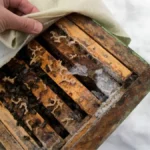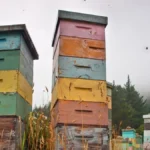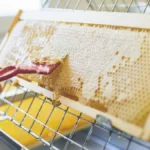When it comes to deciding how much honey to leave bees for winter there are many questions we need to ask. Some people leave no honey for the bees for winter – but they will feed the bees. Others believe that letting the bees have honey makes them stronger. Let us explore our options here so we can choose what works for each person in their unique situation.
Why Do Bees Store Honey?
Many people think bees make honey for us. They don’t. In fact, bees have been making honey long before we even knew how to be humans!! Bees store honey to allow them to survive periods when they cannot gather the resources needed to survive.
This could mean they store honey to survive a long dry spell where there are no flowers, as in the case of warm areas of the world where there is a wet and dry season. They can also store honey to allow them to survive long cold winters where there are no flowers. Bees store honey like we should have emergency savings – to allow them to make it through tough patches.
A Few Common Questions Around Honey Stores:
Now that we know why bees store honey, let us explore a few common questions I get asked about honey stores when I lecture and give talks about bees.
Do Bees Need Honey For Winter?
There are some people that believe that bees need natural honey and others that believe that you can remove all the honey from a hive and feed the bees cheaper sugars at the end of summer so that they can store and use this to make it through the winter. Many countries have managed over a century of management using this philosophy – it seems to have started very well. Now the wheels are falling off and bees are becoming ill.

Learn more about: Making Sugar Water For Bees
It may be a case that we can blame the nutritional poverty of artificial sugar feeds, or it may be that our bees are being poisoned and our beekeeping pastures are so polluted that bees are sensitive to change now. Generally, it appears that beekeepers that leave honey on the hives for winter are reporting fewer losses over winter than beekeepers who feed their hives with sugar. Again, a causal relationship is difficult to prove, because the philosophies of management of these different schools of beekeeping are so divergent that a thousand different factors can contribute to the divergence.
Using logic we can work on the assumption that for millions of years bees have survived on a diet of honey in winter – for 100 years they have survived on a diet of fed sugars – bees have died faster in this period than the previous period. We have spread diseases all over the planet. We spray weird poisons on our crops. We burn things that were under the ground for hundreds of millions of years. Bees are currently unwell. They are less unwell in places where people manage bees less – hence, logically, we can conclude that human management is not always in the best interest of bees.
If you are keeping bees for your own benefit, and want them to be as healthy as possible, it seems that working with the bees for their best health is logical. When working out how much honey to leave bees for winter, allowing them to be as close to a natural state as possible seems to make logical sense in this regard – you may not get 100lb of honey per hive, but the 20lb you get will be healthier for you, and your bees will be healthier too.
How Much Honey To Leave Bees For Winter?
This really depends on where you are in the world. If you are in Alaska and your bees have to spend a VERY VERY long time locked up in a hive for the super cold winter, then they will need significant stores. If you are in Florida or Southern California, and the citrus flowers in late winter and spring, your bees need very little honey to get through winter. They can actually forage for the entire winter and survive.
To find out what the weight of a hive should be going into winter, contact the local State bee extension officer, or a local beekeepers association. There will be a wise old beekeeper who can tell you what works in that area. I have a general philosophy that bees should ALWAYS have 20lb of stores available. Honey flows can stop, and you can get very cold/dry/windy/rainy weather at any time of year. The climate is becoming erratic and we need to adapt to this. I make a point of leaving more honey on my hives now at any time of year. This helps the bees weather funny upsets in climate.
When it comes to working out how much honey bees have, we often get beekeepers asking how much honey is in a deep super, a shallow super, and so on.
How Often Can You Harvest Honey In A Year?
The trick with bees is to let them produce enough honey for you, and enough honey for them. As I say, I have now taken to always leaving a shallow super full of honey for them AT ANY TIME OF YEAR because the world is a mess and the climate is unpredictable. If the bees fill another super, I will take it off! Some years, I can stack five supers on a hive and remove these three times, other years, I will find the bees don’t get over their first super and you harvest nothing.
In order to get a feeling for the answer to this question, you need to keep a logbook for an apiary. Keep as much other data in your logbook as you can – rainfall for that location for that year. Crops that were planted within two miles of the apiary. Forests cleared. Have new suburbs been built in the area? All of these have an impact on forage availability and can influence honey production. I have had one apiary in particular that had a 50-acre Eucalyptus plantation nearby. This apiary produced over 100lb a hive every year in late autumn when the Eucs flowered. One year, a logging company came and removed the trees – the apiary went from producing 100lb a hive to half of the hives absconding due to starvation.
The short answer – you can harvest honey from bees as often as you have a crop to harvest! As long as you leave enough for them to survive. This is not an answer that will help you write a business plan, but it is an honest answer based on three and a bit decades of joy and disappointment that I have experienced as a beekeeper.
I know I have not answered your question of “How much honey to leave bees for winter” and that is precisely because there is no one size fits all answer to this question. But I have armed you with the tools to find out the answer to this question in your area, and your environment. If you enjoyed this article please share it.
Read more about: How To Keep Bees Alive In Winter

Dr. Garth A. Cambray is a Canadian/South African entrepreneur and beekeeper with 28 years of experience in apiculture and specializes in adding value to honey. His Ph.D. research developed a new advanced continuous fermentation method for making mead that has resulted in a number of companies globally being able to access markets for mead. His company, Makana Meadery, exports honey mead to the USA where it is available to discerning connoisseurs. He has also developed technologies to commercially manufacture organic honey vinegar in Zambia for export globally. He holds a few patents globally in the ethanol industry and believes in technology and knowledge transfer for human development and environmental sustainability. One of his proudest achievements is the fact that the wind farm he started at one of his old apiary sites has essentially made his hometown carbon neutral.






